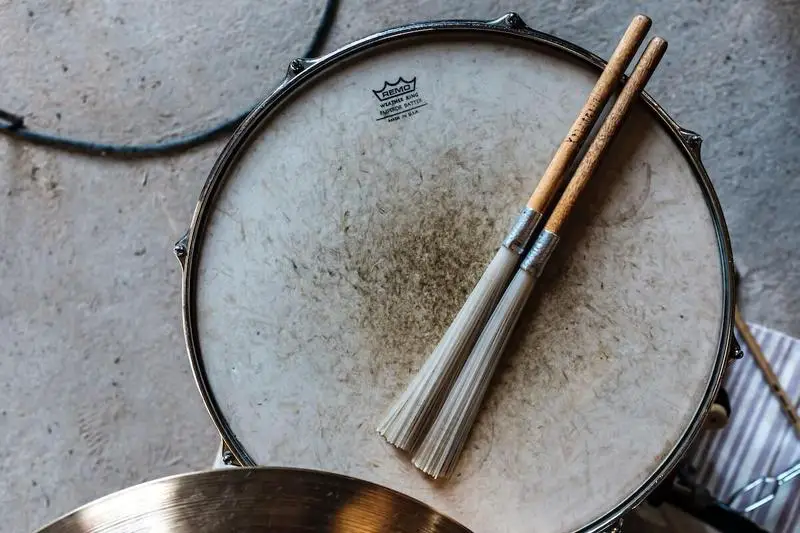Drums Too Loud When Practicing? Here's What You Can Do


Drums are an awesome instrument. Part of what makes them so awesome is their incredible dynamic range; in other words, they can be loud. This presents a real problem for people like myself that live in densely populated areas, or those sharing their living spaces. Luckily for us, this is a common problem with a lot of solutions.
If your drums are too loud when practicing, there are 3 main options: a different kit, using accessories, or finding new ways to practice. The most effective (but expensive) route is to switch to an electronic kit or acoustic with silent heads and cymbals. A cheaper option is dampening your drums, be it with old towels or purpose-made tools. Finally, changing your playing or finding a new way to practice is a great, free, and easy option.
In this article I’m going to explore a wide variety of ways to make your daily practice session a quieter one. This includes the type of drum kit you use, products and gadgets to help, simple changes you can make, or even alternative practice methods that are sure to be neighbor-friendly.
Table of Contents
Which kit should I buy for quiet practice?
If you’re noise-conscious and looking for a new kit, there are several options to consider.
Firstly, a good quality electronic kit is great for everyday practice. Any electronic kit will let you listen to your playing through headphones, and most decent models allow you to route music through them too. This makes playing to music easy, and gives the full experience of a normal kit with far less noise.
That said, e-kits aren’t silent. The sound of sticks on rubber isn’t significant but can still cause problems if you have a close neighbour. To avoid this, place the kit away from any shared walls and put a thick rug or foam riser under it.
You could also consider a practice pad kit. These are exactly what they sound like – a kit made up entirely of practice pads. These are low volume, small, portable, and certainly serve their purpose. However, there are of course a couple of downsides.
These kits have no cymbals, no hi-hat pedal, unrealistic ergonomics, and an overly bouncy stick response. A better (if more expensive) option is to use low volume cymbals and mesh heads on a real acoustic kit. This is covered in the next section.
How do I make my acoustic kit quieter?
If you’re already the proud owner of a noisy old acoustic, fear not. There’s a whole host of things you can do to decrease your kit’s volume.
First off, try the free and easy options.
Free ideas you can try to make your acoustic kit quieter
It’s always best to try the easy options first.
Take your resonant heads off, stuff your kick drum with some blankets or pillows, and cover each of your drums with an old towel. Got a mouse mat collecting dust? Try taping chunks of it onto your cymbals! Alternatively, you could use wads of folded tissue paper.
These are simple tricks that work surprisingly well and won’t cost you a cent. If you’ve tried them out and your kit is still too loud, the next easiest idea is to change your sticks. Using a lighter pair (e.g. 7A drumsticks) or switching to rods will make a big difference.
However, they will also play differently. This is especially true in the case of rods which have a drastically different feel.
Products and accessories you can purchase to make your kit quieter
Next up, there’s a number of products designed to help with this issue.
Firstly we have dampeners. These are a simple, quick, and inexpensive solution to try out. They’re essentially a purpose-built version of the towel trick, and work well for what they are.
Watch out though – they do change the feel of your drums significantly.
Some products that avoid this flaw are mesh heads and low volume cymbals. I believe these to be the best choice for high quality practice if you can afford them.
Mesh heads and low volume cymbals are great at imitating a real kit’s feel. Unlike dampeners, e-kits, or quieter sticks, the rebound and response you get is extremely close to the real thing. This eliminates most of the adjustment period that comes with switching to regular heads and cymbals.
You can even take the same kit out gigging with a quick head and cymbal switch! Finally, you can also play on parts of the kit that most electronic or practice kits forgo. This includes drum rims/shells, cymbal bells, etc.
None of these are an option for me! What else can I do?
Are none of these feasible? Tried them all and nothing’s worked? Here are some ideas for quieter practice which you can implement right now.
- Play quieter! This might sound like a silly suggestion, but ultimately the only thing controlling your volume is you. Dynamic control is a great skill to have, strengthening your creativity and expression on the instrument. While always practicing softly isn’t a good idea, this is a valid option for part-time noise constraints.
- Use a practice pad. If you have a pad you already have a fantastic quiet option at your fingertips. Pads are fantastic for developing technique and stick control. You can even practice coordination, stomping your feet without pedals!
- If you don’t have a pad, try creating a makeshift kit out of soft surfaces. This could be pillows, books covered with cloth… Anything goes. You’d be surprised at how well you can train coordination, round-kit dexterity, and a variety of other skills this way. The only thing that may suffer is technique. It should come as no surprise that pillows don’t provide the best stick rebound!
Outside of these ideas, there are so many ways to get your daily dose of practice in. For one, reading or transcribing music is an amazing talent to develop. Actively listening to music will usually teach you something, even if you don’t realise it. It might shock you to hear that even just visualizing practice can help you improve.
So come on, no excuses. Go practice – quietly!
You may also like
- DIY Rutes: How To Make Your Own Multi-Rod Drumsticks
- How To Stop Drums Ringing And Getting A Tight, Controlled Sound
- Electronic Drums: Pros & Cons You Need To Know Before Buying
- Best Drums For Toddlers: Wood, Electronic And Hand Drums
- How Much Does A Drum Set (Acoustic & Electric) Cost In 2023?
- How to Practice Drums Without a Drum Set: Improve Your Skills at Home
Who we are
AboutDrumming.com is run by a group of drum teachers, drumming professionals and hobbyists. We love all things drums, and when not drumming we spend our time adding more awesome content to this website!
Free tools
You may also like
- DIY Rutes: How To Make Your Own Multi-Rod Drumsticks
- How To Stop Drums Ringing And Getting A Tight, Controlled Sound
- Electronic Drums: Pros & Cons You Need To Know Before Buying
- Best Drums For Toddlers: Wood, Electronic And Hand Drums
- How Much Does A Drum Set (Acoustic & Electric) Cost In 2023?
- How to Practice Drums Without a Drum Set: Improve Your Skills at Home
Affiliate Disclosure: When relevant AboutDrumming.com uses affiliate links (at no additional cost to you). As an Amazon Associate I earn from qualifying purchases.